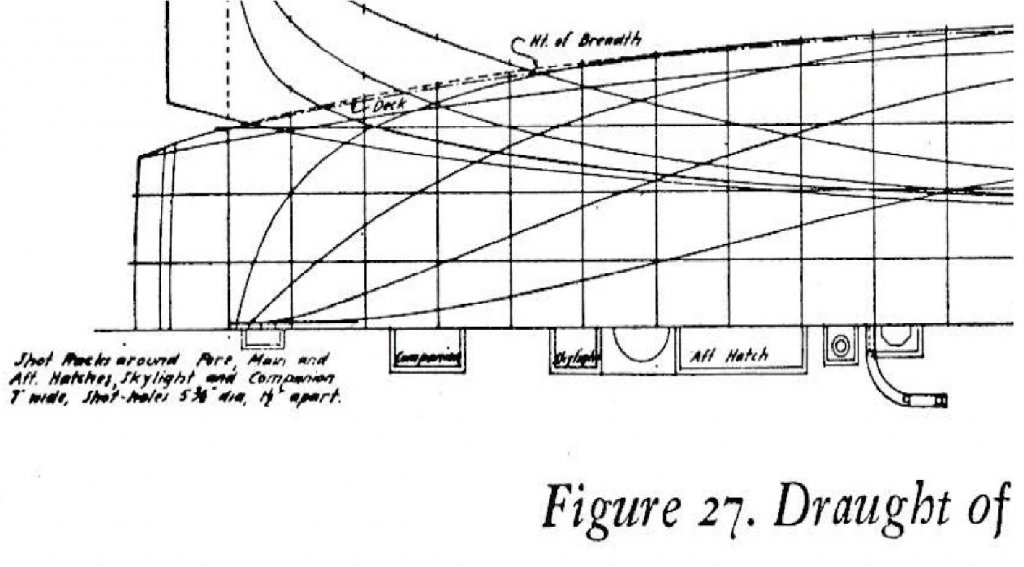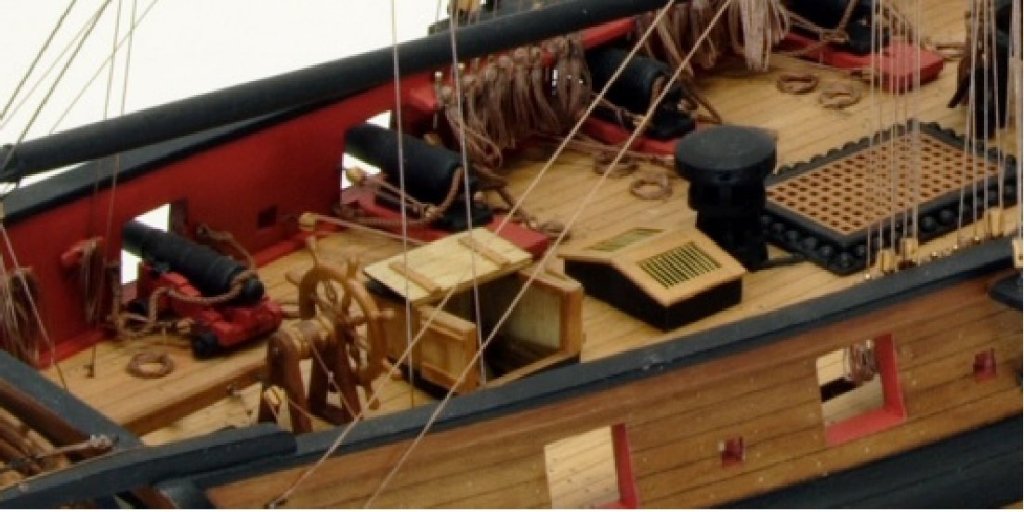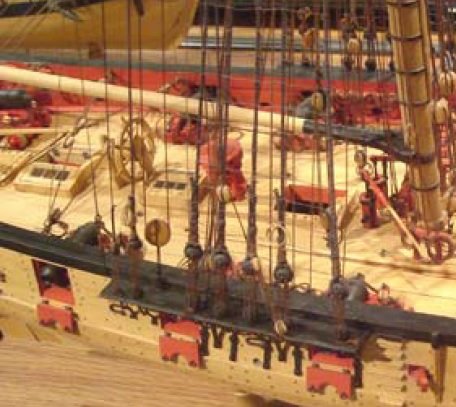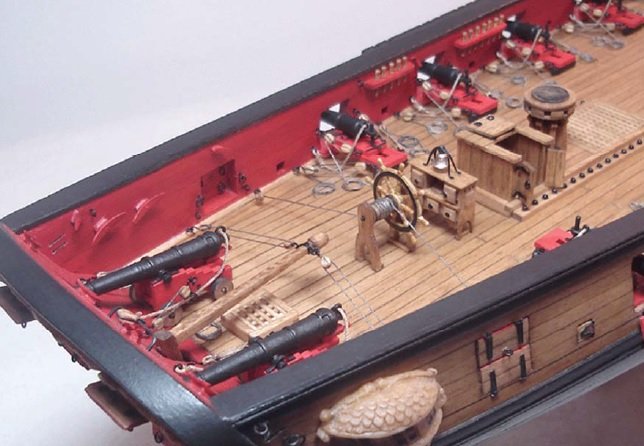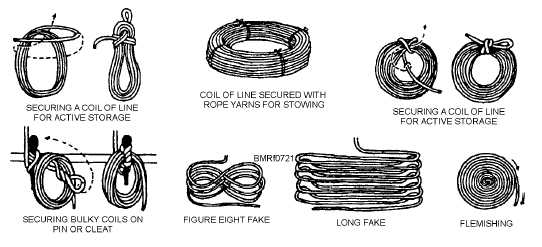
el cid
Members-
Posts
143 -
Joined
-
Last visited
Content Type
Profiles
Forums
Gallery
Events
Everything posted by el cid
-
Peter, Really, really nice build, thanks for sharing your progress and techniques. I did note one very minor issue that you may or may not want to address before you start masting and rigging. Double check your rigging of the steering tackle, I think the lines should run from the top of the steering drum instead of the bottom. Seems the way the lines run now, when the helm is put over in one direction, the tiller will also be pulled in that direction, which will cause the rudder (and vessel) to move in the opposite direction. Again, a very minor issue that few (if any) would ever notice (and I bring it to your attention with some hesitation). Cheers, Keith
- 242 replies
-
- syren
- model shipways
-
(and 1 more)
Tagged with:
-
And re: the presumed reason for painting bulwarks red, i.e., to prevent panic by concealing blood and gore, which I never gave much credence to. Perhaps this has led folks to assume bulwarks were a bright, fresh-blood color of red. But, maybe the “red” was to help conceal the dark, brownish color of dried blood instead? Spanish Brown would be just the ticket for concealing those stubborn hard-to-clean blood stains. I don’t really believe this and continue to think paint color was selected based on CO, XO, or bosun’s preference, local availability, and cost (and later by regulation). Fun discussion. Cheers, Keith
-
I’ve been thinking the same, but without any real evidence. Bulwark “red” perhaps wasn’t the relatively bright red commonly used on models, but more of a reddish brown (oxide red) like you show. Nice work looking at actual ship manifests for evidence.
-
I’ve two of these boat kits on order from a supplier in Russia and am looking forward to building them. Even though they are 1/72 scale, I intend to adjust them as appropriate and use them to fit out my 1/64 Syren as the cutter and barge (in addition to the kit-supplied launch). Would it make sense to also scale these boat kits at 1/64 or is the difference between 1/72 and 1/64 too minor? Best regards, Keith
-
Roger nailed it above. I don't have any experience sailing a square-rigged vessel, but on my little sloop, adjusting the rake of the mast even a little can noticeably change the way she handles. Below is a relevant excerpt from a message sent by Lt. Stewart, Commanding US Brig Syren to Captain Preble in USS Constitution on 01 January 1804 (during the Barbary War, sourced from the US Navy History of same)... "The 27th we sailed and kept company with the United States Brig Argus until the 29th. At midnight, a severe gale of wind came on with a tremendous sea that hove the Syren on her beam ends and filled her waist full of water. We got her before the wind, knocked out some of the ports, and freed her decks. The jolly boat was stove to atoms and lost. Nothing but strong gales from the westward, with heavy squalls (that prevented our carrying any sail but storm stay sails) prevailed from the 2nd of December to the 12th, during which time we were driven considerably to the eastward and all my officers sick but two young and inexperienced midshipmen." Later in port... "I immediately commenced the necessary repairs that the Brig requires. She leaks very much in her upper works, which has damaged some of the provisions and other articles. I am therefore under the necessity of caulking. Her rigging we take this opportunity of overhauling and also to shift her main mast further aft, which it requires, and feel confident it will much improve her sailing. I left at Leghorn Robert T. Spence, Midshipman, whose mind had been for some time deranged. He is a son of Mr. Spence, Purser of the Philadelphia". Cheers, Keith
-
Looks really good. Seems the gun ports would be closed when carrying a boat at the stern. Cheers, Keith
- 227 replies
-
- syren
- model shipways
-
(and 1 more)
Tagged with:
-
Nice subject and interesting box-type bulwark construction, looks like its coming together nicely. Any indication what scale it is? Thanks for posting and please continue as you progress. Cheers, Keith
- 45 replies
-
- woody joe
- sir winston churchill
-
(and 2 more)
Tagged with:
-
Thanks for the replies. To help illustrate my confusion, below is the relevant section of the drawing from Chapelle, an unknown model of Syren from the web, the USNA museum Syren (Lightly model), and the MS Syren configuration (Chuck's interpretation). I'm still conflicted on exactly which deck opening(s) would most likely be used for access below (i.e. the ladderway/companionway) and which (if any) would be a skylight for below deck lighting/ventilation. Any thoughts welcome. Cheers, Keith
-
Wow! Just Wow!
-
Mondfeld in "Historic Ship Models" (p. 144) indicates that an opening in a ships deck to allow access below is either a "companionway" (merchant ships) or "ladderway" (warships). He then describes a "companion" as an opening in the deck of a warship that provides light and ventilation and is normally covered by a removable "skylight" but that is not a ladderway. I ask because the plans for SYREN provided in Chapelle's "History of the American Sailing Navy" (p. 185) indicate both a "companion" and a "skylight" aft of the capstan, but no ladderway. Trying to reconcile with Chuck's plans (ie. did Syren have a skylight too?). Any insight appreciated. Keith
-
I think the lines attached to the anchor cable are "stoppers" (not sure how/if different then "nippers"). They are made fast to iron rings on the deck then secured to the anchor cable to ensure that an anchor can't run away if it somehow breaks loose. On modern ships chain stoppers and pelican hooks are used. HTH, Keith
- 1,306 replies
-
- syren
- model shipways
-
(and 1 more)
Tagged with:
-
Looking very nice. Re: the anchor stowage, I'll offer my opinion as a retired US Navy Sailor and as a private recreational sailor, not as an expert on period ground tackle practice. Number one rule when getting underway was/is to secure all gear (especially heavy items) for sea. Sometimes there isn't a dedicated storage space (or rack, cradle, fitting etc.) for all equipment, but sailors will be creative in finding a way to secure things to whatever is available...often involving the liberal use of rope. So, I suggest just putting yourself in your miniature bosun's place. How could/would you secure that anchor with the available fittings? I would keep in mind that you shouldn't secure to anything that would interfere with operating (or fighting) the vessel. Also, small ships pitch and roll a lot (sometime a LOT), consider how well your anchor will be secured against heavy rolls. And don't forget possible chaffing, ropes would be protected where they lead over edges on which they might rub. I suspect there is no absolute right way of securing that anchor, it would be the preference and judgement of the bosun and first lieutenant...now you. FWIW, Keith
-
Re: ship's lights. Below is a transcribed diary entry from a midshipman in SYREN during her expedition with INTREPID to burn the frigate PHILADELPHIA. I did my best to interpret the 12-hour clock times given to 24-hour time. Second para mentions lights, but doesn't indicate where they were displayed. Taken from "Naval documents related to the United States Wars with the Barbary Powers" five volumes of which are available online. Many interesting SYREN factoids within...grueling schedule for the small US force involved. Midshipman F. Cornelius deKrafft 16 February 1804 Commences with fresh breezes, clear and pleasant weather. The Intrepid in company. At 0230, made the land on our lee bow. Hauled up the mainsail, took 1 reef in the topsails, and bent the stream cable. At 0330, backed the main topsail for the Intrepid to come up. At 0400, lowered down the cutter and sent 9 men on board the Intrepid with cuttlasses, pistoles, musquets. etc. At 0430, the boat returned, hoisted her up and made sail for the land. At 0530, mountain Togura (6 or 8 miles to the E of Tripoli) bore SSW, town of Tripoli SW. At 0600, tacked to the NW. At 0730, boarded main tack. At 0930, tacked to the SW, set staysails and jib. At 1000, called all hands to quarters and run out the guns, hauled down staysails and jib, and hauled up square mainsail, brailed up after mainsail. At 1030, spoke the Intrepid. At 1100, backed the main topsail, sounded and got no bottom. Midnight moderate and clear, lost sight of the Intrepid. Hauled up the foresail, backed main topsail, sounded in 35 fathoms and filled away. At 0100, sounded in 14, 12, and 9 fathoms (from 0100 to 0400 standing off and on the shore). Showing lights for the Intrepid (which were answered). At 0100, called all hands to quarters, run in the guns and secured them, shipped the ports, wore and stood off shore. Made sail, the Intrepid on our lee bow. At 0800, the high land near Tripoli bore SW by W, 7 leagues. At 1100, the Intrepid tacked to the S and E. Noon, wore to the S and W, handed square mainsail, reefed the foresail, and set after mainsail. Moderate breezes and pleasant. The Intrepid bearing S ½ E, 8 miles distance.
-
These are amazing works of art, thank you for sharing. To me your talent is simply magical. Warm regards, Keith
-
Ropewalk
el cid replied to Worldway's topic in Rope Making/Ropewalks's Rope Materials and parts resources
"Gathered 3 threads and twisted clockwise until they wanted to kink, and tucked it in my hand until I had all 3 twisted to the kink point, laid them together and from the end twisted counter clock wise, had what I needed. With the addition of some more hands or holding devices you can make rope without a rope walk". This is the same general process for I use for making up "Flemish twist" bowstrings, although I can't imagine starting out with thread. Archers also serve the center portions of their bowstrings. Not sure how ship modelers begin and end their servings, but this link provides an elegant (IMHO) method used for bowstrings. Perhaps of some use to others (and I apologize if this is old news). Keith -
I think some of the old movies (e.g., Mutiny on the Bounty) show sailors scrambling up to the top. Makes me queasy just thinking about it. Cheers, Keith
-
Hey Mike, Are you familiar with the crew manual at Brig Niagara website (http://ssvniagara.com/wp-content/uploads/2017/02/niagara-crew-handbook.pdf)? On page 45 it provides a belaying diagram that shows the topgallant halyard (I think that's what your diagram is describing) belayed to a pinrail on the starboard side. Don't know which source should be judged most definative, but perhaps an option. HTH, Keith
-
I'm no expert on the rigging question, but considering the purpose of this line, I would think it would be cleated off on something, not half-hitched to itself. Would it be wrong to have a cleat mounted on the mast there? Sorry I can't help resolve conclusively (but you probably won't go too astray if you think like a sailor, they were/are pretty practical). Cheers, Keith
-
Good discussion and I'll add my 2 cents re: the "flemishing" of lines when not in use. I doubt this was common practice, except as someone mentioned, in preparation for an inspection or other ceremony when not underway. For longer lines that needed to run cleaning and quickly, "faking" the line on deck ensures it runs without twisting or tangling, flemishes don't necessarily run out cleanly. A longer line might also be neatly coiled on deck in what we referred to as a "birds nest." Warships are typically kept clean and orderly and I doubt lines were left faked, coiled, or flemished on deck for significant periods of time. Ships are very dynamic (rocking and rolling, shipping water on deck, etc) and crowded, so prudence would dictate that everything is well secured when underway. Found the below image from a modern US Navy training manual: Cheers, Keith
-
Hi Scott, I'm new to NRG and wooden ship modeling, but have dabbled in plastic and resin for some time. If you're not aware, there's another modeling site that tends to focus more on "modern" warships, primarily plastic and resin, and I've found the guys there very helpful (like NRG guys). There's actually a specific thread there on the Queen Elizabeth class battleships: (http://www.shipmodels.info/mws_forum/viewtopic.php?f=47&t=4719) If you don't get a response here, you might try asking over there. Moderators, I trust I'm not violating forum policy by linking to another site, if so please delete and I'll refrain from doing it anymore. HTH, Keith
-
It seems common practice for modelers to leave their vessel's false keel "un-coppered", however the "General Instructions for building a Sloop of War" (appendix p. 517 in Chapelle's "The American Sailing Navy") states "The false keel as well as the bottom of the keel to be coppered before they are fastened together." I can't find any further info re: these "General Instructions" (Chapelle doesn't provide the source or date of this reference), so was hoping others here might provide insight on the applicability of coppering the false keel. Cheers, Keith
About us
Modelshipworld - Advancing Ship Modeling through Research
SSL Secured
Your security is important for us so this Website is SSL-Secured
NRG Mailing Address
Nautical Research Guild
237 South Lincoln Street
Westmont IL, 60559-1917
Model Ship World ® and the MSW logo are Registered Trademarks, and belong to the Nautical Research Guild (United States Patent and Trademark Office: No. 6,929,264 & No. 6,929,274, registered Dec. 20, 2022)
Helpful Links
About the NRG
If you enjoy building ship models that are historically accurate as well as beautiful, then The Nautical Research Guild (NRG) is just right for you.
The Guild is a non-profit educational organization whose mission is to “Advance Ship Modeling Through Research”. We provide support to our members in their efforts to raise the quality of their model ships.
The Nautical Research Guild has published our world-renowned quarterly magazine, The Nautical Research Journal, since 1955. The pages of the Journal are full of articles by accomplished ship modelers who show you how they create those exquisite details on their models, and by maritime historians who show you the correct details to build. The Journal is available in both print and digital editions. Go to the NRG web site (www.thenrg.org) to download a complimentary digital copy of the Journal. The NRG also publishes plan sets, books and compilations of back issues of the Journal and the former Ships in Scale and Model Ship Builder magazines.


